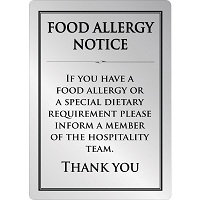February 17, 2026
Join us as we bring planners and suppliers together to unpack the real dynamics behind successful partnerships.
Register Today!
Food Allergies, What Do I Do?

Food allergies are becoming more common than not, which can make planning or organizing any event, regardless of size, intimidating. On the flip side, attending an event as a participant who has an allergy, some would argue, is even more intimidating. As an individual living with celiac disease, I can personally attest to the sheer panic that rushes through me when a plate of food is placed in front of me at a networking event. I start to question it because I don’t know the people at my table, the full ingredients list of what is on my plate, and how the meal was prepared. I don’t want to be rude and send my plate back or explain my disease to table full of strangers, but food allergies are no joke.
Common food allergies today range from milk, eggs, peanuts, tree nuts, soy, wheat, grains, and fish. Symptoms can be as small as an uncomfortable rash or as severe as death. So, how does a planner take into account all of these food allergies while still satisfying everyone’s needs and have a safe and successful event? Here are a few tips.
- Start at registration. Create a safe space where the attendee can communicate their allergy and what it entails. Be sure to provide confirmation to the attendee that their allergy has been accounted for, will be well sought after, and will be executed carefully and properly. It is ultimately the responsibility of the attendee to communicate their allergy, but then the responsibility falls on the planner to communicate the allergy with all the personal involved with planning the menu, ordering the food, preparing the meal, and serving the meal to the attendee.
- To make it easier on the planner and catering staff, offer a wide variety of simple foods that can easily be altered to accommodate all allergies and restrictions. Providing simple options, will allow the chef to easily prepare a made from scratch plate, in a safe environment, for attendees that require special attention. If the menu you wish to offer does not allow for this type of flexibility, plan to have allergy friendly meals safely prepared in advance.
- Buffets are an easy and cost effective way to serve a large quantity of people; not to mention they can be uniquely themed, adding an element of creativity and fun to your event. In a buffet setting, clearly label each dish and all the ingredients the offering contains so attendees can rest assure they know what they are consuming. To take it a step further, list out what allergy the dish accommodates (Example: “Peanut, Soy, and Gluten Free Friendly).
- Communication is key. Reiterate and repeat concerns at every step of the planning process and in every communication. If you don’t understand what the attendee is asking for, keep asking questions until you do. Be sure to include everyone, management, front of the house, back of the house, and so forth, so if they get blinded sided with a question from an attendee the day of the event, they will know how to respond.
Cheers to fun and safe events for all!


Leave a commentOrder by
Newest on top Oldest on top